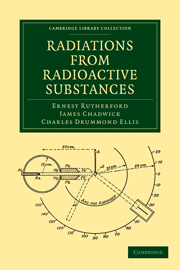Book contents
- Frontmatter
- Contents
- LIST OF PLATES
- Preface
- Chap. I Radioactive Transformations
- Chap. II The α Rays
- Chap. III Absorption of the α Rays
- Chap. IV Some Properties of the α Particle
- Chap. V Theories of Absorption of α Rays
- Chap. VI Secondary Effects produced by α Rays
- Chap. VII General Properties of the Radiations
- Chap. VIII The Scattering of α and β Particles
- Chap. IX The Collisions of α Particles with Light Atoms
- Chap. X The Artificial Disintegration of the Light Elements
- Chap. XI The Radioactive Nuclei
- Chap. XII β Ray and γ Ray Spectra
- Chap. XIII The Disintegration Electrons
- Chap. XIV The Passage of β Particles through Matter
- Chap. XV The Scattering and Absorption of γ Rays
- Chap. XVI Intensity Problems connected with the Emission of γ Rays
- Chap. XVII Atomic Nuclei
- Chap. XVIII Miscellaneous
- Appendix
- Subject Index
- Index of Names
- Plate section
Chap. XVIII - Miscellaneous
Published online by Cambridge University Press: 07 September 2010
- Frontmatter
- Contents
- LIST OF PLATES
- Preface
- Chap. I Radioactive Transformations
- Chap. II The α Rays
- Chap. III Absorption of the α Rays
- Chap. IV Some Properties of the α Particle
- Chap. V Theories of Absorption of α Rays
- Chap. VI Secondary Effects produced by α Rays
- Chap. VII General Properties of the Radiations
- Chap. VIII The Scattering of α and β Particles
- Chap. IX The Collisions of α Particles with Light Atoms
- Chap. X The Artificial Disintegration of the Light Elements
- Chap. XI The Radioactive Nuclei
- Chap. XII β Ray and γ Ray Spectra
- Chap. XIII The Disintegration Electrons
- Chap. XIV The Passage of β Particles through Matter
- Chap. XV The Scattering and Absorption of γ Rays
- Chap. XVI Intensity Problems connected with the Emission of γ Rays
- Chap. XVII Atomic Nuclei
- Chap. XVIII Miscellaneous
- Appendix
- Subject Index
- Index of Names
- Plate section
Summary
§124. The apparent radioactivity of ordinary matter. It was pointed out by Schuster in 1903 that every physical property discovered for one element had later been found to be shared by all the other elements in varying degrees. On such general grounds it might perhaps be expected that the instability shown by the elements uranium, thorium, actinium, and their products should be a property common to all matter. It is indeed true that every substance which has been examined shows a feeble radioactivity which can be detected by the ionisation method, but it seems probable that in all cases, with the two exceptions of potassium and rubidium, this activity is to be ascribed to the presence of traces of bodies belonging to the well-known radioactive families rather than to an instability of the element itself.
The early investigations of C. T. R. Wilson on the rate of loss of charge of an insulated conductor in a closed vessel indicated that the ionisation was produced by a radiation proceeding from the walls of the vessel. This view was confirmed by the experiments of Struttf, who found that the rate of discharge of an electroscope depended on the material of which it was composed. In some cases markedly different rates of discharge were found for different specimens of the same metal, indicating that in these cases at least a large part of the effect was due to radioactive impurities. On the other hand, Campbell concluded from an extensive series of measurements that all metals showed a specific radioactivity and emitted characteristic radiations of the α ray type.
- Type
- Chapter
- Information
- Radiations from Radioactive Substances , pp. 537 - 568Publisher: Cambridge University PressPrint publication year: 2010First published in: 1930



